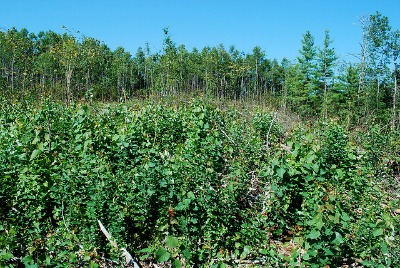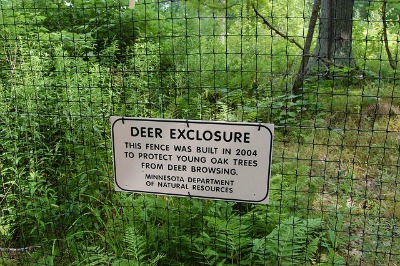Renewing a forest—to replace harvested trees or those that died from insects, disease, fire, old age, or extreme weather events—is key to sustainable forestry. Foresters refer to the process of establishing new tree seedlings as “regeneration.” They also refer to the seedlings established in the forest as “regeneration.”

Regeneration can be accomplished through two basic approaches: (1) natural regeneration, which occurs when new seedlings or sprouts are produced by trees left on or near a site (as with aspen), and (2) artificial regeneration, more commonly known as tree planting. This article will address the steps involved in tree planting.
Identifying Your Reasons for Planting Trees
Before you jump into ordering and planting trees, you need to take a few preliminary steps. What and how you should plant will depend, in part, on how you plan to use your property. Therefore, it is important to develop a vision for your land and set goals to meet your particular interests and needs. For example, if are you a bird watcher, you could attract songbirds by planting fruit-bearing trees or species that provide attractive nesting habitat.
Evaluating the Site
After you have decided what you want your land to be, the next step in planning your forest is to evaluate the site. Every location is different, and the chosen plants, planting methods, stand layout, and maintenance activities will depend on a thorough evaluation of your site. With this evaluation, you should assess the climate, soil type, existing vegetation, topography, location in the landscape, and conditions in surrounding forests.
Choosing the Appropriate Trees and Planting Design
With your site evaluation in hand, you are ready to develop a planting design that meets your goals and is appropriate for the conditions found on your site. Developing a planting design involves deciding which trees to plant where and in what arrangement. Of course, selecting the right trees for your site will give your forest the best chance for growth and survival. Also, you will best meet your goals by using the most appropriate planting arrangement. For example, to maximize tree growth and make maintenance easy, plant trees in rows. If you want to minimize the visual impact of rows of trees, consider alternating rows of conifers and hardwood trees. To create wildlife habitat, create clumps of trees for shelter. Also, consider safety aspects when developing your planting arrangement. Leaving space around the planting and roads within the planting will create firebreaks around and within your planting, which will slow or stop wildfires from burning your trees.

Preparing the Site
Preparing a site for planting is an often-overlooked, yet important, part of establishing a successful plantation. Implementing a few simple steps can mean the difference between achieving a healthy planting and one in which trees struggle to survive. The main objective in site preparation is weed control. Controlling weeds allows trees to become established without competition for water, sunlight, and nutrients. To determine the most effective and cost-efficient method of site preparation, consider soil type, existing vegetation type and density, and your time and financial constraints.
The two main site preparation methods used prior to tree planting are mechanical site preparation and chemical site preparation. Mechanical site preparation involves the use of various types of machinery and tools to prepare the planting site. Chemical site preparation entails using commercially produced herbicides. Prescribed burns and cover crops can help as well, but mainly in combination with other methods.
Using Proper Planting Techniques
Careful handling of tree seedlings from the nursery to the planting site is a critical component of a successful reforestation effort. Seedlings are living organisms, and they require certain conditions to maintain good health and vigor. Proper care and handling of seedlings can protect your investment and ensure that your forest plantation has the best start possible. The main techniques for planting trees are hand planting and mechanical planting. The choice of which type of technique to use depends primarily on the terrain and the size of the planting area.
Caring for Your Trees
Often, the success of a new tree planting is determined by the follow-up care you provide. Caring for new tree plantings includes monitoring survival; continuing to control competing vegetation; providing protection from animals, such as deer or rodents; and monitoring for disease and insects. Weather also will play a role in the success of your new tree planting. You cannot control the weather, but by following through on the factors you can control, you can help reduce many impacts from the weather.
Adapted with permission from: Creating a Forest: A Step-by-Step Guide to Planting and Maintaining Trees
Contributor
Kris Tiles, University of Wisconsin-Extension
